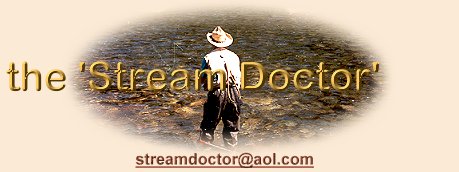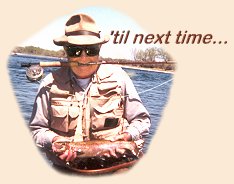
| ||
|
April 5th, 2004
|
|
Q. We all know that trout eat insects, but what do insects eat? I would be interested to know in general terms, what caddis eat. Thanks, Aaron
A.
Well, Aaron, insects in general, including caddis,
have a fairly broad range of food resources. Rather
than just give you a list of foods, it might be more
instructive to add a bit to help you understand.
Basically, there are 3 major sources of food available
to stream insects; these are:
(2) Fine Particulate Organic Matter (FPOM) which
includes all pieces of organic matter less than 1
mm in diameter, and
(3) instream plants including algae and flowering
plants. CPOM includes such things as leaves, twigs,
even logs - anything that reaches the streambed from
either terrestrial or aquatic origin. This material
is eventually broken down and colonized by bacteria
and fungi, thus becoming a nutritious source of food
for insects. FPOM includes the finer pieces of organic
matter originating from the breakdown of CPOM, fecal
pellets from insects, decomposition of algae, etc.
The most important sources are FPOM and algae,
especially the algae covering the surface of rocks
and other solid objects, making them slick to the touch.
There are some minor functional feeding groups that
ecologists have used for specialized insects. These
include gougers, insects which gouge their food
from the surface of submerged logs; piercers, insects
with mouthparts adapted to pierce and suck out the
juices from aquatic plants; and miners, which
burrow in sediments.
Well, you asked for "general terms" but got a bit
more than this. I hope it is of interest.
~ C. E. (Bert) Cushing, aka Streamdoctor 105 W. Cherokee Dr. Estes Park, CO 80517 Phone: 970-577-1584 Email: streamdoctor@aol.com
|
| If you would like to comment on this or any other article please feel free to post your views on the FAOL Bulletin Board! |
[ HOME ]
[ Search ] [ Contact FAOL ] [ Media Kit ]
 The 'Stream Doctor' is a retired professional stream ecologist and
author, now living in the West and spending way too much time
fly-fishing. You are invited to submit questions relating to
anything stream related directly to him for use in this Q & A Feature
at
The 'Stream Doctor' is a retired professional stream ecologist and
author, now living in the West and spending way too much time
fly-fishing. You are invited to submit questions relating to
anything stream related directly to him for use in this Q & A Feature
at